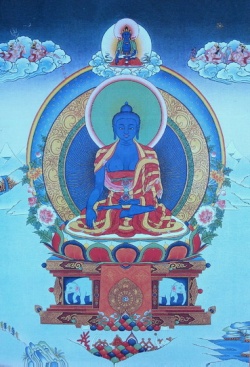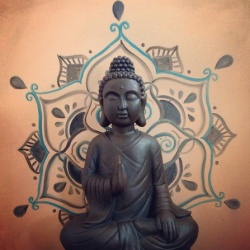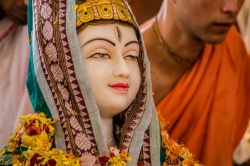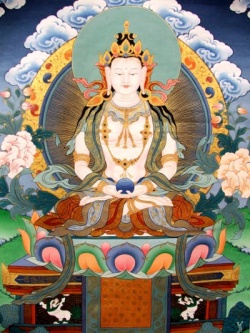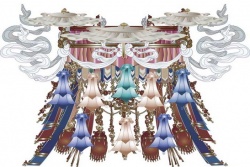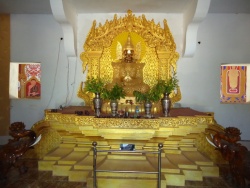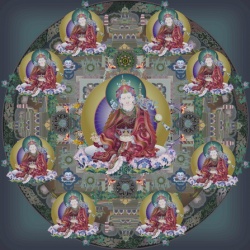Taking Refuge as a Protection Against Suffering
Taking Refuge as a Protection Against Suffering:
The Formal Ceremony Of Entering the Buddhist Path
Good evening. Tonight we have a Refuge Vow ceremony. No doubt you all understand what the Refuge Vow is, based on your reading or hearing of certain instructions. However, I will go over it briefly. As you know, there are three sources of refuge. The sources from whom one seeks refuge or to whom one goes for refuge are the Three Jewels, and these are the Buddha, Dharma and Sangha. The reason one goes for Refuge to them is that you recognize samsara as being a situation of suffering and fear. In order to alleviate that suffering and to remove the cause of that suffering, you go to the sources of refuge as protectors from the cause of suffering.
Generally speaking, there are two styles of going for Refuge. We are going through a two-stage process. There's a style of going for refuge to the Buddha, Dharma, and Sangha in their external form as something separate from oneself. This is based on relative reality, an approach of relative reality. There's another style of refuge based on absolute reality where you go for refuge to the Three Jewels as something internal, as something that is part of your mind. From this second point of view, the Buddha, Dharma and Sangha are not far away from you. They are quite close to you. As a matter of fact, they are so close that you can't see them.
Outer Refuge As The Basis For Engendering Confidence
In the initial ceremony, we're principally concerned with the external refuge. We take refuge in the historic Buddha. We take refuge in the Dharma, the teachings of Buddha. And then we take refuge in the Sangha, the Assembly, as our companion. The outer form of refuge is simply a confirmation through our body, speech, and mind of the inner-most discovery of refuge, of taking refuge simply within our heart, within our mind. Taking refuge in the outer sense, which we are going through right now, is the process of restrengthening and confirming our confidence, our trust, and our basic sense of courage in order to further our understanding and realization of this enlightened heart.
An analogy for this is to imagine we are sitting in our room, and we say, "I am going to give five dollars to pan-handler tomorrow when I go out on the street." You know, we have that sort of nice, enlightened, compassionate heart. But when we walk outside and see a pan-handler, we may have the instinct to simply pass by without any effort to bring our wallets out of our pockets. It's very simple and easy to just pass by the panhandler the next day. This is like having some sense of inner refuge but not going Taking Refuge as a Protection Against Suffering by Dzogchen Ponlop Rinpoche.
We may pass by a panhandler and say,
"OK, I don't have the money now but I'm going to bring you five dollars tomorrow." You promise that to him, and then you go back to your home. The next day, when you go out, it's pretty sure that you will have the five dollars to give to him or her on the street. When you go out next day, there's a much stronger commitment involved. You know that you will really give five dollars rather than just think about giving. Therefore, taking refuge in the outer sense strengthens our heart, our path, and practices. That's why the outer refuge is so strongly emphasized in entering the path of Buddhadharma. We take refuge in the Buddha as an example, in the dharma as the path, and in the Sangha as our companion. These are the three outer refuges. The Buddha, Dharma And Sangha As Objects For Refuge
The Buddha
The first object of our refuge is the Buddha Sakyamuni, the historic Buddha. The Buddha, as a teacher, protects by teaching. When we take refuge in the Buddha, we're taking refuge in Buddha Shakyamuni and in all of the Buddha's of the past and future. When we take this refuge in Buddha as an example, we're not taking Buddha as a god or as some supernatural being outside of ourselves. We're taking refuge in the Buddha as a basic human being, a supreme human teacher, who has achieved the complete state of enlightenment.
We take refuge and pay respect to the Buddha Shakyamuni not only because of his attainment of enlightenment but because of his compassionate, loving heart, and his sharing of his path, sharing of his enlightenment with all of us. In order to show our appreciation for his kindness and his wisdom, we pay respect. We bow to Buddha. We take refuge in Buddha Shakyamuni as a simple teacher, as a Nirmanakaya Buddha and teacher. He was a human being. He was a prince of India. He walked on our earth. He ate our food. He went through all the suffering and pain of human beings, and the suffering and pain of many dathuns.
Not only one month long but six months, or six years of dathun practices. Through this, we have a basic connection with Buddha. We can make a basic connection with Buddha from the pain of dathun sitting. As a real human being, he went through this path and achieved the final realization of enlightenment. In this way, he is an example for us. He has given us the wisdom and realization of this path, and he did not keep anything for himself.
He gave everything for us. Therefore, we take refuge in the perfect Buddha, the Samyak-sambuddha, and his mind which is the dharmakaya. We appreciate his wisdom and kindness. He taught out of his great love and his great wisdom methods that can lead one to the same attainment he had. And just as he, through training in the path leading to liberation and omniscience, succeeded in actually attaining Buddhahood, so will I. Because if he can do it, then I can. That is the attitude of going for refuge in the Buddha as an example.
Buddha himself proclaimed in one of his first teachings, "Buddhas cannot purify your karma with water," referring to the Hindu notion of purifying one's karma by bathing in the River Ganges. Buddha said, "I cannot purify your karma by pouring water from a golden vase, a diamond vase, or whatever vase you have. I cannot purify your karma, your negativities by that means." He said, "I cannot give my realization to you by my hand. I cannot transfer my realization. I don't have that power." However, he also said, "What Buddhas can do is show the path of liberation, the path of enlightenment. It is totally up to you how you walk on this path, how you handle this path." From this very verse, we can see that we're not taking refuge in the Buddha as a supernatural being outside who hold our keyboard. (Laughter.)
What Buddha is saying here is that you are holding your own keyboard. What you are learning from him is the command keys. (Laughter.) You are learning the skill of pressing the keys to get the programs you want to see on the screen. The keys are always in front of us. It's only a question of our knowledge whether we press the right key or not. What Buddha is teaching us is the path, the way we can attain enlightenment, liberation.
He is not saving us from samsara. He does not have the power to purify our karma and so forth. We're not taking refuge in the Buddha in that sense. We're taking refuge in the Buddha in the sense that he is an enlightened teacher, and he has shown the right path of enlightenment and liberation. He is an example of our capacity or potential. We go to him for refuge in the sense of aspiring to attain exactly that same realization. That is the Nirmanakaya Buddha, the historic Buddha. Then we have the Sambhogakaya Buddha, another form of the Buddha, and the Dharmakaya Buddha, the wisdom aspect of the Buddha. We're taking refuge in his three kayas.
The Dharma
The second source of refuge is the Dharma. Going for refuge to the Dharma as external means taking the Dharma as your path. You recognize that the way you can attain the state of Buddhahood, the way that you can follow the example of the Buddha, is by practicing the Dharma which was taught by the Buddha. So when you go for refuge to the Dharma as external, you are going for refuge to the methods of the path by which one frees oneself from mental affliction. This is called Sat-dharma, or genuine Dharma. Dharma as symbol traditionally consists of books, letters, speech and thought.
Traditionally, we have the Buddhist Canon, and then we have all kinds of other expressions of the speech aspect of Dharma, such as audio-dharma, video-dharma, hard copy dharma, CD Rom dharma, and one last thing, floppy dharma. (Rinpoche laughs) No, floppy disk dharma. I have lots of those. You trust these as a path which means that you trust that the practice of Dharma will increase your compassion. The Dharma is a necessary vehicle or method on our path to enlightenment. It is like a toolbox to liberation. In order to fix something like a screw, whether you have to loosen the screw or tighten the screw, we need a screwdriver and various different tools. In a similar way, we need the Dharma, as the external teachings of the Buddha, in order to work with our problems, to fix them and find our solutions. Taking Refuge as a Protection Against Suffering by Dzogchen Ponlop Rinpoche.
Traditionally, the Dharma is said to be like a ship. If you want to cross a lake or an ocean, you have to rely on a ship. Dharma is like the boat or ship which helps you across. It helps you travel faster and not sink in this ocean of samsara. So Dharma is the path, Dharma is the words and wisdom of Buddha, and Dharma is simply one's own understanding, experience, and realization. Our relationship with the Dharma is like our relationship with a boat or ship. After we have crossed the water, there's no need for us to carry the boat or ship. Therefore, after we have crossed the ocean of samsara, then we no more take refuge in Dharma. We have realized the nature of Dharma. We have become Dharma. We are inseparable with Dharma. That is the second refuge in the outer sense.
The Sangha
The third source of refuge is the jewel of the Sangha or the community of noble, realized beings. This refuge also has the same external, symbolic aspect. The external aspect of the Sangha to which one goes for refuge is first and foremost the retinue of Lord Buddha endowed with wisdom. From the Mahayana point of view, this refers to Bodhisattvas like Arya Manjushri, Avalokitesvara and so forth, and from the Hinayana point of view, the great arhats such as Mahakasyapa, Ananda, and Shariputra. The Sangha of ordinary individuals refers to all of those who have transmitted the Dharma, the teachings of Buddha, as an unbroken succession or lineage through time up to the present day through their wisdom and compassion. We take refuge in the noble Sangha as our companion on the path.
Without their help, there's no way we can really enter the path. Historically, they are the people who received teachings from the Buddha and then collected all of these teachings and put them on paper. Without the noble Sangha, we would not have any words, any literature of Dharma right now. Therefore, we take refuge in the Sangha as our companion because, without them, we wouldn't have the physical body of the Dharma. Without them, we wouldn't have the genuine lineage of the Dharma, the realization of the Dharma, or the path of the Dharma. From the time of the noble Sangha up until now, the time of our present great masters, we have the continuity of the teachings, continuity of the enlightened path.
Provisional and Ultimate Refuge
At the same time, the Dharma and the Sangha, the second and third sources of refuge, are considered to be provisional or temporary sources of refuge in the sense that once the path is completed you no longer need them. You have become the Buddha. The Buddha is considered to be an ultimate source of refuge in that you are continually sustained by or protected by your own Buddha Nature which is the substance of your awakening as well.
In the traditional simile of the Dharma as boat, our personal teacher is the captain of the boat and embodies the companionship of the Sangha. When we take refuge in the Dharma and Sangha in this way, we rely on their help, to a certain degree, until we are across the lake or the ocean. When we're trying to get from one side of the water to the other side, we need the boat and the boatsman to row us across. But once we get to the other side, we don't need them any more because we are already there. However, right Taking Refuge as a Protection Against Suffering by Dzogchen Ponlop Rinpoche.
now, we're on this side of the lake, not the other side, so we still need them. Once we are across the lake, it is logical that we don't have to carry the boat around. We just leave the boat behind, and we just leave the captain in his own way. We don't bother him so much. After we reach a certain point, we have to learn how to walk on our own feet, leaving the boat and captain behind. Therefore, taking refuge in Dharma and Sangha is not really the ultimate refuge. The ultimate refuge is the Buddha, the wisdom of the Buddha. We temporarily take refuge in the Dharma and Sangha like going for help to the ship and the ship's captain.
That is our symbolic refuge which is involved in the refuge ceremony; we take refuge in the outside, historic Buddha, his teachings, the Dharma, and the Sangha as our companion.
The Inner Refuge In The Fundamental Nature Of Our Own Mind As Indivisible From Buddhahood
The Buddha
The innermost sense of refuge is the discovery of our own basic nature of mind which is the nature of Buddha's wisdom. In the context of absolute truth, we go for refuge to the fundamental nature of our own mind which is indivisible from the jewel of the Buddha. The nature of Buddhahood itself is luminous, naturally cognizant wisdom, usually referred to as the dharmakaya, or the body of essential qualities. Our fundamental state of mind is totally awake, totally in the state of fully awakened heart. Rediscovery of that heart, making a connection with that heart, again, is what we call taking refuge in the Buddha.
You know, that's what Buddha is. Buddha is basically the wisdom of awakened mind, and that awakened mind is nothing "outside" but is within this very nature of our mind. Making a strong connection with that discovery is what we call taking refuge. It is an extremely, extremely close connection. That connection is basic confidence, basic faith, basic trust that we develop through our discovery.
We're making a commitment to discover our own basic nature as being the wisdom of Buddha, to uncover that, to work on the development of our basic potential of Buddha, the dharmakaya Buddha. Dharmakaya is always within our being, within all sentient beings. We possess the basic qualities of the Buddha from beginningless time. On the one hand, we are Buddha from the beginningless time. But, on the other hand, this Buddha quality potential is covered by our defilements, our obscurations.
The klesa mind and cognitive obscurations are covering our basic Buddha qualities. So we make a commitment that we are going to work on clearing these obstacles and generating our basic Buddha quality up to the extent that we can fully radiate this quality outside as an historic Buddha. That is the fundamental notion of taking refuge in the Buddha as being within our own nature. Now, to recognize that the nature of our mind is Buddha Nature is the beginning of the process of revealing that nature. By revealing that nature, then we can dispel all the sufferings and all of the fears of samsara. So to recognize that our mind's nature is Buddha Nature, to have confidence or faith in this, and to have the aspiration and commitment to reveal this is the internal way of going for refuge. Taking Refuge as a Protection Against Suffering by Dzogchen Ponlop Rinpoche.
The Dharma
Taking refuge in the Dharma in the more sane sense is becoming one with the path of fully developing this discovery of essence, this discovery of seed. Whatever we have discovered, at this point, as an enlightened heart is not yet fully grown, is not yet at the stage of fully grown enlightened mind. Our discovery is a little shaky at this point. It is a very, very profound discovery but, at the same time, it's very shaky, and it's very tricky. At a certain point, it becomes very clear, and we're very confident. And then, on the other hand, we have lots of doubts.
We have lots of shaky states that we go through which means we have not fully developed this discovery. We have not fully mastered or familiarized ourselves with the new discovery that we have made or the new connection, or reconnection that we have started. Therefore, the path in this case is the Dharma, taking refuge in the Dharma, which is the genuine path. And that genuine path is nothing but your realization on the path. It is the internalization of Dharma, making yourself one with the Dharma instead of looking at Dharma as path which is outside you.
That is the inner-most sense of taking refuge in the Dharma, becoming one with the path, becoming one with the teachings. Going beyond the language and words of Dharma and simply being Dharma, being in the state of Dharma, being in the state of path is what we call taking refuge in Dharma. That taking refuge in Dharma involves a complete trust, a complete confidence, and complete sense of being which we talked about the other day as the mindfulness of mind.
The Ultimate Dharma , the refuge of Dharma connected with absolute truth, is the arisal of Dharma in your mind, which is to say, the point at which your mind and the Dharma are totally mixed, and you become the Dharma. Ultimately, it is the mixing of the meaning of Dharma with your mind such that your actions and state of body, speech and mind are always in accordance with the Dharma. So the real Dharma is realization and, as an ultimate source of refuge, is not anything outside you or separate from your mind. Nevertheless, in order to increase one's realization of ultimate Dharma, one goes for refuge to the Dharma which is a commitment to generating and increasing this realization.
Although Buddha Nature is present within you, it is not revealed. It is still hidden or obscured. It's presence, and the recognition of its presence, or trust in its presence are not in themselves enough to dispel the sufferings of samsara. In order to actually dispel those sufferings, you have to fully reveal this Buddha Nature. You have to make it's qualities manifest. Now the process of revealing it, or the methods by which it can be revealed, are what we call Dharma.
To train in these profound methods for gradually revealing your own Buddha Nature, which involves enhancing or developing both wisdom and compassion, is going for Refuge in the genuine Dharma.
The Sangha
The third refuge is taking refuge in the Sangha. Taking refuge in the Sangha is the outcome of the first two. After you have discovered this basic heart of enlightenment, after you have familiarized yourself with that, internalized it as the path, then whatever comes out of it as a product and as a result is what we call the Sangha. What manifests from these two first discoveries of enlightened heart and the path of enlightenment is a Taking Refuge as a Protection Against Suffering by Dzogchen Ponlop Rinpoche.
The warmth, the loving heart which manifests
out of these two first discoveries is what we call taking refuge in Sangha. So that is the companion. Our companion is loving-kindness, our companion is bodhicitta, our companion is love for others, our companion is compassion for others. That is the notion of Sangha here and of taking refuge in the Sangha in the inner-most sense. That is the true refuge that we are taking. There is no form involved. It is a simple, genuine, straightforward heart that you have discovered, and re-strengthening that heart is what we call taking refuge.
When we become one with the Dharma and are in the process of generating this basic Buddha quality, then we are a part of the Sangha.
The actual refuge of the Sangha arises when we realize the qualities of the truth of cessation and are then able to help and instruct others. The ultimate Sangha is what happens to our mind when we enter and progress on the path of Dharma, and Dharma starts to become actualized within us. Through engaging in this process of revealing our own fundamental nature, our compassion for other beings as well as our natural wisdom increases and flourishes. As a result, we become able to benefit both ourselves and others. This act of benefiting others is what is meant by going for refuge to the Sangha
Commitments Of The Refuge Vow
Commitments of Restriction
The commitments associated with going for refuge are the following. Having gone for refuge to the Buddha, it is taught that you should not seek the protection of or go for refuge to powerful, mundane beings, worldly deities, or lokapalas. The reason for this is that the ultimate refuge is your own innate Buddha Nature. No source of protection, no source of refuge, can match that. You have within yourself all of the qualities complete.
It is unnecessary to try to acquire these from beings external to yourself. The image that is used for this is of someone who owns a vast treasury, a treasure house filled with jewels. It is unnecessary for such a person to go out and try to find jewels. Therefore, in recognition of this, there's no need to go for refuge to mundane beings. Having gone for refuge to the Dharma, it is taught that you should abandon all that is harmful to other beings. Even in situations where you cannot benefit other beings, you should do your best to minimize, as much as possible, whatever harm you do to them. At best, one should actively help but, failing that, one should try to refrain from getting engaged in any painful attitude or action that would produce pain in others.
Having gone for refuge to the Sangha, it is taught that when you find yourself in situations where your friends, your companions, or your entire environment are leading you away from the Dharma, you should exercise mindfulness and vigilance. If you let go of your mindfulness and vigilance in such a situation, you will become unable to help others and you, yourself, will be at risk of being led astray. As long as one has no ability to actually help others, then one is more likely to be influenced by others than to influence them.
If you constantly accompany people who actively destroy your virtuous Taking Refuge as a Protection Against Suffering by Dzogchen Ponlop Rinpoche. tendencies, then not only will your virtue be easily destroyed but they will also further destroy their own. The situation will harm everyone involved. We can use the example of people who are involved in negative karmas like hunting, fishing, and so forth. If we hang around with these friends too much at the beginning stage of our practice of Dharma, we might become influenced by them.
We might start thinking, "Well, maybe it's interesting. Maybe it's nice to fish or shoot." Something like that may occur in our minds. We may decide to try it once or twice. Then we get drawn into the situation and get involved in negative karma. But once our practice has been strengthened, then it is important for us to be there and try to help in whatever way we can. So our commitment is to be more mindful and aware when we go out into our regular samsaric world. The whole world that we live in has a lot of sharp edges. If we are not mindful and aware, we may get cut by these sharp edges instead of turning them into beautiful flowers. Until the time that we actually generate the qualities associated with the path, our commitment is to exercise some caution in allowing ourselves to come under the influence of people or groups who are actively engaged in things that harm others. Is that clear? (Rinpoche laughs)
So these three are called the commitments of restriction.
Commitments of Performance
Next are the three supplementary commitments, or the commitments of performance. They're quite simple. They are to respect, especially in your attitude, symbols of the Buddha, Dharma and Sangha. After taking refuge in the Buddha, we respect all forms of the Buddha, such as statues, pictures, paintings or any images of the Buddha. It is the same for the Dharma and the Sangha. We show respect for the texts and for symbols of the communities of ordained men and women. For example, we should not walk over a statue of the Buddha or a text that we have left on our cushion.
However, it's important to understand that respect here does not mean adopting any particular cultural form. The point is the internal attitude of respect, not particularly how it is demonstrated externally. So this is not an injunction to attempt to adopt a particular cultural form. You should demonstrate respect with body, speech and mind in a way that is in accordance with your cultural background. So that's about enough commitments. (Rinpoche laughs.) Shall we dedicate the merit?
